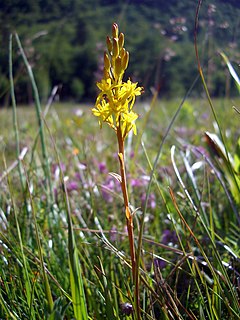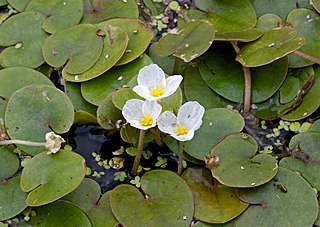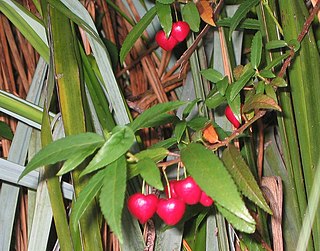
Vallisneria is a genus of freshwater aquatic plant, commonly called eelgrass, tape grass or vallis. The genus is widely distributed in tropical and subtropical regions of Asia, Africa, Europe, and North America.

Narthecium is a Eurasian and North American genus of herbaceous flowering plants. This genus was traditionally treated as belonging to the family Liliaceae, but the APG II system of 2003 placed it in the family Nartheciaceae.

Hydrocharis is a genus of aquatic plants in the family Hydrocharitaceae described as a genus by Carl Linnaeus in 1753. It is widespread across much of Europe and Asia, plus a few scattered locations in Africa. It is also reportedly naturalized in parts of North America.

Aletris, the colicroot, colicweed, crow corn, or unicorn root, is a genus of flowering plants in the Nartheciaceae family, native to North America and to eastern and southeastern Asia, especially China. It was used as a component in Lydia Pinkham's original Vegetable Compound.

Ephedra sinica is a plant species native to Mongolia, Russia, and northeastern China. It has been proposed as a candidate for the legendary soma of the Rigveda.
Vallea ecuadorensis is a species of tree in the Elaeocarpaceae family. Although formerly considered endemic to Ecuador it has also been collected in Bolivia and Peru. This species occurs in subtropical or tropical moist montane forests, at 2500 – 3500 meters above sea level.

Plumeria obtusa, the Singapore graveyard flower, is a species of the genus Plumeria (Apocynaceae). It is native to the West Indies, southern Mexico, Belize, Guatemala, and Florida. but widely cultivated for its ornamental and fragrant flowers around the world, where suitably warm climate exists. It is reportedly naturalized in China.

Halodule is a genus of plants in the family Cymodoceaceae described as a genus in 1841. It is widespread on tropical and semi-tropical ocean shores of all continents except Europe and Antarctica.

Thibaudia is a genus of flowering plants in the family Ericaceae. They are native to Central and South America with a high concentration of species in the cloud forests of Costa Rica and Ecuador. Species of the genus are known commonly as zagalitas.

Hygroryza (watergrass) is a genus of Asian plants in the grass family.

Najas marina is a species of aquatic plant known by the common names spiny water nymph, spiny naiad and holly-leaved naiad. It is an extremely widespread species, reported across Europe, Asia, Africa, Australia, the Americas and many oceanic islands. It can be found in many types of freshwater and brackish aquatic habitat, including bodies of alkaline water.

Tofieldia is a small genus of flowering plants described as a genus in 1778. It is widespread across much of Europe, Asia, and North America.

Blyxa is a genus of an aquatic plant of the family Hydrocharitaceae described as a genus in 1806.
Dubouzetia is a genus of about eleven species known to science, growing from shrubs up to large trees, in Papuasia and Australasia and constituting part of the plant family Elaeocarpaceae.

Najas gracillima, the slender waternymph, is a submerged species of aquatic plant in the Hydrocharitaceae family. found in lakes and streams. It is native to China, Russian Far East, Japan, Korea, Taiwan, Iran, Alberta, Ontario, Newfoundland, Nova Scotia, New Brunswick, the eastern United States. It is also considered introduced and naturalized in France, Spain, Italy and California.

Limnobium, common names spongeplant and American frogbit, is a group of aquatic plants in the Hydrocharitaceae described as a genus in 1814. It is widespread in freshwater environments in Latin America, the West Indies, and the United States.

Vallea stipularis is a species of tree in the Elaeocarpaceae family. It is native from the Andes mountains in South America.

Aristotelia peduncularis, also known as heartberry, is a shrub in the family Elaeocarpaceae, endemic to the wet forests of Tasmania

Orthotrichum lyellii, also known as Lyell's bristle moss, is a species of acrocarpous moss belonging to the family Orthotrichaceae. O. lyellii can be found throughout western North America and Europe. It is found most commonly growing epiphytically on a variety of trees, and less commonly on rocks or boulder substrates.

Actinoscirpus is a monospecific genus in the family Cyperaceae which contains only the species Actinoscirpus grossus. It is found across East and South Asia and is known in China as 大藨草.


















